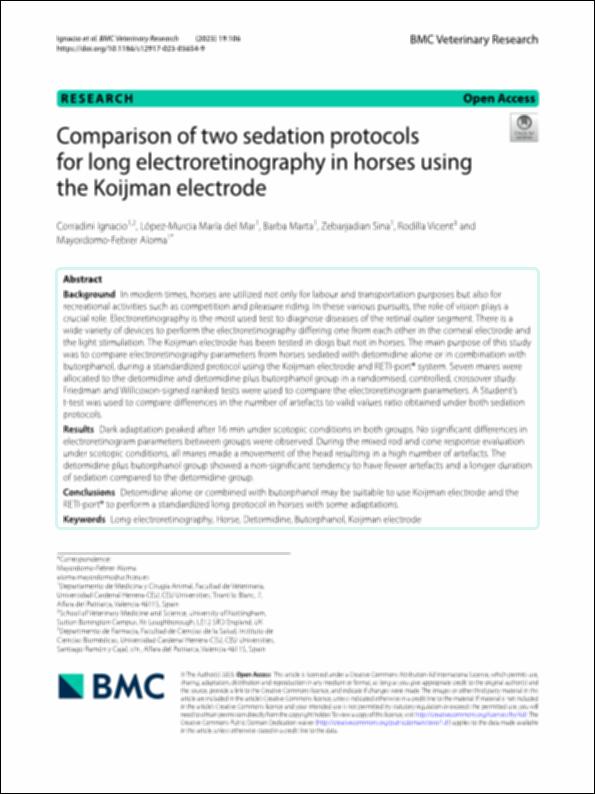Please use this identifier to cite or link to this item:
http://hdl.handle.net/10637/16049Comparison of two sedation protocols for long electroretinography in horses using the Koijman electrode
| Title: | Comparison of two sedation protocols for long electroretinography in horses using the Koijman electrode |
| Authors : | Corradini, Ignacio López Murcia, María del Mar Barba Recreo, Marta Zebarjadian, Sina Rodilla Alama, Vicente Mayordomo Febrer, Aloma Tadea |
| Keywords: | Veterinaria; Veterinary medicine; Caballos; Horses; Electrorretinografía; Electroretinography; Anestesia veterinaria; Veterinary anesthesia; Electrodos; Electrodes |
| Publisher: | BioMed Central |
| Citation: | Corradini, I., López Murcia, M.M., Barba, M., Zebarjadian, S., Rodilla Alama, V. & Mayordomo Febrer, A.T. (2023). Comparison of two sedation protocols for long electroretinography in horses using the Koijman electrode. BMC Veterinary Research, vol. 19, i. 1, art. 106 (04 aug.). DOI: https://doi.org/10.1186/s12917-023-03654-9 |
| Abstract: | Background: In modern times, horses are utilized not only for labour and transportation purposes but also for recreational activities such as competition and pleasure riding. In these various pursuits, the role of vision plays a crucial role. Electroretinography is the most used test to diagnose diseases of the retinal outer segment. There is a wide variety of devices to perform the electroretinography differing one from each other in the corneal electrode and the light stimulation. The Koijman electrode has been tested in dogs but not in horses. The main purpose of this study was to compare electroretinography parameters from horses sedated with detomidine alone or in combination with butorphanol, during a standardized protocol using the Koijman electrode and RETI-port® system. Seven mares were allocated to the detomidine and detomidine plus butorphanol group in a randomised, controlled, crossover study. Friedman and Willcoxon-signed ranked tests were used to compare the electroretinogram parameters. A Student's t-test was used to compare differences in the number of artefacts to valid values ratio obtained under both sedation protocols. Results: Dark adaptation peaked after 16 min under scotopic conditions in both groups. No significant differences in electroretinogram parameters between groups were observed. During the mixed rod and cone response evaluation under scotopic conditions, all mares made a movement of the head resulting in a high number of artefacts. The detomidine plus butorphanol group showed a non-significant tendency to have fewer artefacts and a longer duration of sedation compared to the detomidine group. Conclusions: Detomidine alone or combined with butorphanol may be suitable to use Koijman electrode and the RETI-port® to perform a standardized long protocol in horses with some adaptations. |
| URI: | http://hdl.handle.net/10637/16049 |
| Rights : | http://creativecommons.org/licenses/by/4.0/deed.es Open Access |
| ISSN: | 1746-6148 (Electrónico) |
| Issue Date: | 4-Aug-2023 |
| Center : | Universidad Cardenal Herrera-CEU |
| Appears in Collections: | Dpto. Medicina y Cirugía Animal |
Items in DSpace are protected by copyright, with all rights reserved, unless otherwise indicated.


